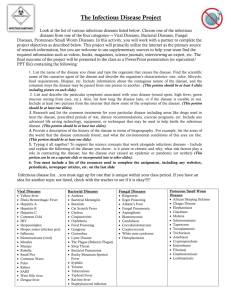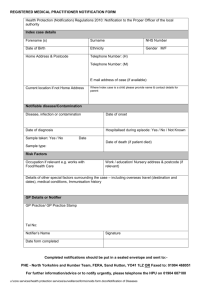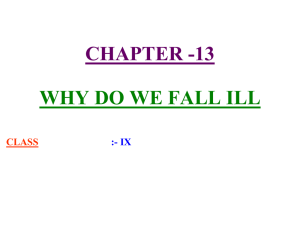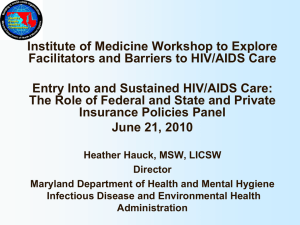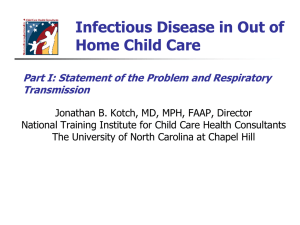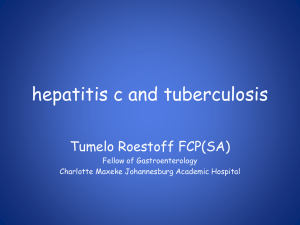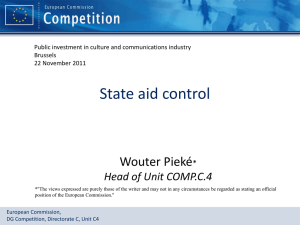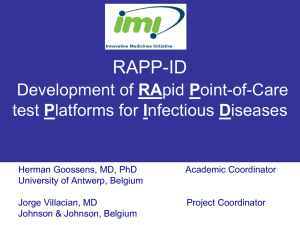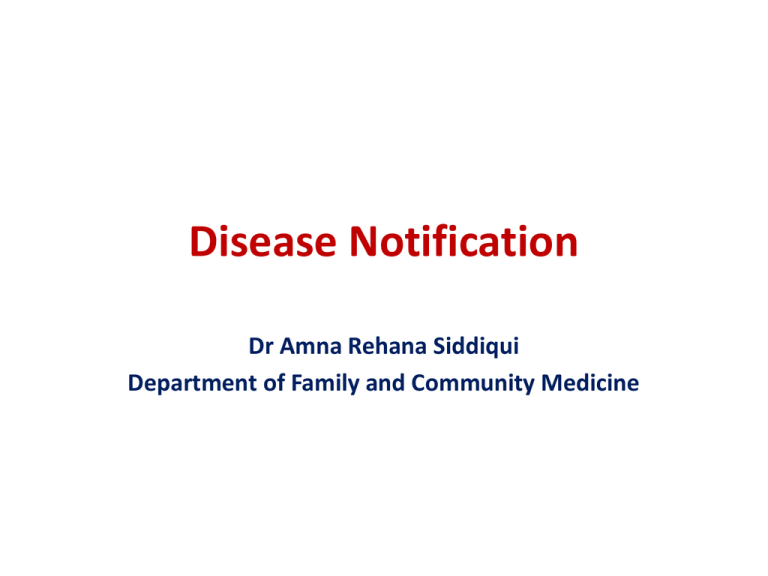
Disease Notification
Dr Amna Rehana Siddiqui
Department of Family and Community Medicine
objectives
At the end of session participants will be able to
• Describe the disease notification process for
major infectious diseases including mortality
• Classify the types of reporting mechanisms
• Justify the role of ministry of health /
department of health in disease notification
system
Background
The communicable disease control requires:
1. Understanding of the epidemiology of diseases
2. Reliable data on its distribution.
Once an infectious disease listed to be reported or a
new disease has been detected (or suspected) it
should be notified to the local health authority,
whose responsibility is to put into operation, control
and preventive measures.
Background: Control of Communicable diseases
• The first step prompt recognition & identification
• Reporting to a higher level remains the first line of
alertness
• All health care workers should be aware of
diseases that need to be reported as well as how,
why & where they are to be reported.
Background
• Administrative practices on diseases reporting may vary
greatly from one country or region to another.
• Disease reporting provides necessary and timely
information to justify the application of appropriate
investigation and control measures .
• Uniformity in morbidity and mortality reporting
allow comparison of data from different time periods,
regions, and nations.
A reporting system functions in four stages
Collection of basic data in the local community where
disease occurs.
Data are next assembled at district, state or province
level.
Aggregation of information under national systems.
For certain diseases, reporting is made by the national
health authority to the WHO.
Reporting System in Saudi Arabia:• Reporting system of communicable diseases passed
through various stages since 1953G/1353H
• Modifications had been undertaken where
reporting was urged to be implemented more
seriously and the diseases were classified into two
main classes.
Reporting System in Saudi Arabia:Class I:
• Included quarantinable diseases such as
Cholera, Plague and Yellow fever
and
• other communicable diseases such as
Poliomyelitis and Cerebrospinal meningitis of
various origins as well as other diseases.
Reporting System in Saudi Arabia:• Diseases under class 1 should be reported
immediately from hospitals, to the responsible
health care center to regional health affair
directorate and eventually to the Ministry of
Health by telephone, fax or most rapid means.
• The diseases should be reported to the general
directorate of preventive medicine by fax.
Reporting System in Saudi Arabia:Class II:
Diseases included this class should be reported weekly from
the assigned health care center to the regional health affair
directorate and then monthly from the latter to the general
directorate of preventive medicine in the Ministry of Health.
This class include communicable diseases which are closely
related to environmental health
e.g. Typhoid, Amoebic dysentery, hepatitis, and other diseases,
please see table in next slides.
Channel of Reporting
Preventive Sector of Department of Communicable
diseases
Directorate of Health
Primary Health Care Center
*
Infection Control Department
Physicians In:
Hospitals belonging to Ministry of Health (MOH) and
other government sectors
Private Hospitals
Primary Health Care Centers under MOH
Private Dispensaries and Private Clinics
* In Big Cities PHC can report directly to Directorate of Health
Epidemiological monitoring of Infectious Diseases by Ministry of Health (MOH)
Reason of quick informing to take rapidly the preventive action
System of informing
Ministry of Health Preventive Sector
Directorate of Health Services
Hospitals
Primary health care centers
Class I: Suspected infectious Diseases. To be reported immediately (within 24 hrs)
13. Enceph/Mening
14. Dengue Fever
15.Rift V Fever
16. Other
Hemmorhagic
Fevers
In Children < 15
Years of age only
9. Acute F. Paralysis
10. Guillene B Synd
11. Transverse mylitis
12. Other
4.Tetanus Neonatorum
5.Diphtheria
6.Measles
7.Mumps
8.German measles
1.Cholera
2.Plague
3.Yellow fever
-other emerging inf
like Avian
influenza H1N1;
SARS…etc.
Class II: Suspected infectious Diseases. Diseases that need to be reported monthly
33. Pneumococcal
Meningitis
34. Hemophylus
Influenza Meningitis
35. Meningitis Other
Note
29. chicken Pox
30.Echinococus
31.Hemolytic
Uremic Syndrome
32.Rabies
24. Typhoid & Para
typhoid
25. Amebic dysentery
26. Salmonellosis
27. Malta Fever
28. Shigellosis
Any new emerging infectious
Diseases or other diseases that
appear in an outbreak manner
20. Hepatitis A
21. Hepatitis B
22 Hepatitis C
23. Hepatitis/Other
17. Tetanus
18. whooping cough
19. German Measles
in new born
Diseases reported under immediate reporting
should also be included in weekly reporting
Surveillance, Survey & daily reporting
Surveillance (WHO, state, health department,hospital, decide)
• Continuous; frequency of reporting scheduled
• Monitor long term trends
• To make comparisons
• Demands on maintaining quality of data
Survey (WHO, state, health department, hospital, decide)
• one time activity/ prevalence survey/to know burden
• Repeated surveys / yearly / quarterly
Daily reporting
• A structured format: to report to infection control department
• If new emerging infectious disease of fatal nature then health
department need to be notified daily or per decision
Disease notification
Legal responsibility of public & privately functional/working
•
•
•
•
•
•
Physicians
Laboratories
Hospitals
Health centers
Others
Immediately reporting can be done by fax with sufficient
information for the health department to trace and take
actions to confirm the case; and control further
• Within a hospital infection control department assists in
collecting information to process to health department
• Passive type of surveillance
Disease notification
• Instituted for rapid application of prevention
measure
• List of diseases vary by country
• Notification goes by mail
• Information on form includes dx, date of onset, age,
sex, and place of residence; may contain Sx, Rx given,
and precautions
• It is done to control and prevent people in homes,
clinics, hospitals, villages, towns, cities, countries,
and at global level too.
Validity of notification data
•
•
•
•
Seeking of medical care is not constant
Distance to the nearest hospital
Cost and distance to travel
Media reports will increase the # of people
reporting to the hospital e.g. dengue fever
• Public awareness will increase the incidence
Case Definition
• Standard set of criteria
• Clinical and lab
• Allows for comparison
• Sensitive vs. Specific
• New diagnostic tests will
increase incidence
Case Definition Example
• Probable Case of Smallpox
A case that meets the clinical case definition
that is not laboratory confirmed but has an
epidemiological link to another confirmed
or probable case.
• Confirmed Case of Smallpox
A case of smallpox that is laboratory
confirmed.
Case Definition Gradient
Low Specificity
High Specificity
Suspected
Probable
Confirmed
DEATH: Assigning Cause on certificate
• under-registration (of death) (especially where
where registration facilities are minimal).
• The exact determination of the cause of death is
one of the most difficult problems of vital
statistics .
The WHO standard death certificate:
• Disease/condition directly leading to death e.g.
peritonitis.
– Antecedent causes e.g. perforation of duodenum.
– Morbid conditions if any, giving rise to above cause e.g. duodenal
ulcer.
• Other significant conditions, contributing to death but not
related to the disease, or condition causing it … e.g.
hypertension.
Importance of Death Certificate:
• Enables the underlying causes of death to be assigned
to its proper category in the (ICD).
• The WHO consider this classification as one of the
great advances in the field of vital statistics.
• It enables international comparative studies.
• Death from acute infections of short durations act like
incidence of disease
ICD: International Classification system of diseases
Summary
• Disease notification requires an inbuilt
surveillance system between health care
workers/services and government
• Case definitions / cause of death assignment
• Prompt action as soon as notification arrives
• Control measures to be considered for health
care services, community, employees, and
determining target or high risk groups
Exercises
Divide the class into groups ; that work on following scenarios;
1. How to address a new infectious disease epidemic, that was not
endemic in the region/setting?
2. How to notify infectious diseases from admitted patients?
3. How to notify infectious diseases from outpatients?
4. How to notify infectious diseases in medical professionals
/occupational hazards medical profession?
5. How to notify infectious diseases from laboratory ?
6. How to report needle stick injuries in health workers of a
hospital?
7. How to report a suspected case of polio to health department ?
8. How to handle a case of suspected Enteric Fever in hospital
cafeteria cook?
Each group presents its worked out response in front of class

